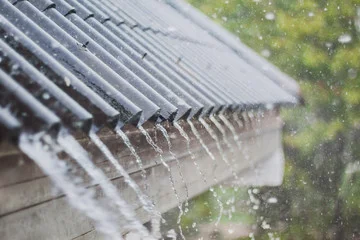
Water storage can be a big problem for those with limited space and no well. But there is a way to still prepare for your water needs in the event of a long term emergency. You can use a Do-it-yourself rainwater harvesting system.
There is more than one way to go about creating your own system to have water when the SHTF. Additionally, rainwater harvesting is one of the most self-sufficient and environment-friendly methods of using water. You are collecting water from the sky as it falls, all the while trying to utilize is as much as you can, and without a price tag looming on it.
The average roof collects 600 gallons (2,271.2 L) of water for every inch of rainfall and you can make a rainwater collection system for under a hundred dollars and store hundreds of gallons of water to use for your garden or other purposes. Make sure you have a filtration system in place before drinking this water just to be safe.
Please be aware that some states have banned rainwater collection and harvesting.
Installing a simple rain barrel to collect water is pretty easy. Through this do-it-yourself tutorial, you can make it in no time and start harvesting water in just four steps. Connecting a rain barrel system to the rainwater drainage pipes is an efficient way of collecting rainwater. What I also like about this tutorial is the reliance on visuals to explain the process, which is always helpful, especially to those who are new to prepping.
What You’ll Need
Obtain one or more water storage barrels. We suggest a food-grade BPA-free plastic water storage barrel (in case this water needs to be used for human consumption). A rain barrel can also be made from a large plastic trash can if you are on a budget and intend to use the water only in a garden or for washing. You’ll want a barrel that will hold 30 to 55 gallons (113.6 to 208.2 L) of water.
- If you decide to get a used barrel, make sure that it didn’t formerly contain oil, pesticides, or any other type of toxic substance. It’s too difficult to clean these chemicals from the inside of the barrel, so using them is too risky.
- If you plan on collecting a lot of water, get two or three barrels. You’ll be able to connect them so they’re all part of the same water collection system and this way you can have hundreds of gallons of water at your disposal.
- 1 standard 1-inch hose spigot with ¾-in. pipe threads, so you can access water from your rain barrel.
- 1 ¾-inch x ¾-inch coupling
- 1 ¾-inch x ¾-inch bushing
- 1 ¾-inch pipe thread with a 1-inch hose adapter
- 1 ¾-inch lock nut
- 4 metal washers
- 1 roll Teflon thread tape
- 1 tube silicone caulk
- 1 “S”-shaped aluminum downspout elbow, to direct water from your downspout to your rain barrel
- 1 piece of aluminum window screen, to keep leaves, bugs and other materials out of your water
- 4-6 concrete blocks
Once you’ve got the supplies needed, level the area next to your downspout by clearing away any debris. Make sure you’ve cleared an area big enough to fit all the barrels you’d like to use. Put down a layer of pea gravel. This will provide better drainage around the rain barrels and help keep water away from the foundation of your home. Dig a 5-inch deep rectangle in the area you leveled to accommodate the rain barrels, and fill it with 1⁄2 inch (1.3 cm) of pea gravel. If you are putting barrels on concrete, don’t worry about the pea gravel. Stack the concrete blocks on the pea gravel to create a raised platform for your rainwater barrels.
Drill a spigot hole in the side of your barrel. It should be high enough up on the barrel to fit a bucket or water jug underneath. Make a 3/4-inch hole to properly fit the spigot you bought. Use caulk on both the inside and outside of the hole. Put the spigot and the coupling together. Use Teflon tape to wrap the threaded ends to create a tight seal and prevent leakage. Put a washer on the threaded end of the coupling and insert it through the hole in the barrel from the outside. Slip another washer over the pipe from the inside. Attach the bushing to hold the spigot in place.
(For pictures, please click here or watch the video below)
Next, make an overflow valve. Click here for detailed instructions if you are using more than one barrel. Put a filer at the top of the downspout so leaves and debris stay out of your water. Connect the downspout using the “S” elbow to your rain barrels.
This is just a simple way to start collecting rainwater, and there is more than one way to do this. Make it work for you and your situation. Prepping really isn’t a “one size fits all” deal. We all have different setups and needs, so create something that works for you. If something doesn’t work in this guide, scrap it and find what does work. We simply hope this gives you ideas on how to better prepare for an emergency.
Also, if you are new to prepping, don’t worry about trying this! We all started somewhere and as you get more ideas, you’ll be able to discover new and innovative ways to make things work for you in your current situation. Most preppers are here to help and offer advice that’s worked for them personally. If nothing else, you’ll come away with some great ideas on how to advance your preparedness.











got a system like the one above off my shed into a ibc tote. cleaned the clear poly carbonate roof today and started it collecting water again. have to shut it down so it wont freeze in the cold months. put a piece of aluminum window screen on the top to keep mosquitos out. garden plants love rainwater. if i need to drink the water i will put some bleach in. id post a pick of my setup but i dont know how. screened out the compost and added it to the beds. gonna start some seeds soon.
Make sure to check your local laws. In lots of area you do not own the air rights above your property. You can not legally collect rain water on your property. Kid you not. I was shocked.
Going Thirsty sucks. Do rain water catch system also for farm animals or to attract wild animals to your homestead. Having a water source for wild critter will find their way to your catch and keep coming back daily. And that’s another instant food source.
If this site still operated as it used to, there at least three or four guys that live on Catchment could tell you how to do it safely. There is a University of Hawaii publication that tells you how to do it. But someone got pi ssed off and ruined the site. If I wasn’t on Data limited Satellite and power limited I’d think about taking it over.
Catchment is easy and you don’t have to pay Democrats for your water.
If one does not have a rain water collection system for their home it should seriously be considered. It will give you vital water security. Plans can be found everywhere on-line.
One inch of rain on one acre of ground equals 27,154 gallons. There is 43,560 square feet in an a square acre. Therefore, in a one inch rainfall about .623 of a gallon will fall on each square foot of area.
So, using my house for example, my roof has 2900 square feet of area, with two slopes, each slope has 1450 square feet of area – since only the rear slope collects the rain to save I calculate 2900 / 2 = 1450 ft. sq. Your roof area will be different, but using the following figures will show how much rain water you can collect.
For each 1 inch rain (using my roof as an example):
step 1 – 1 acre = 43,560 ft. sq.
step 2 – 1,450 ft. sq. (roof slope area) / 43,560 = .0332 acre
step 3 – 1 acre inch water = 27,154 gal.
step 4 – .0332 x 27,154 = 903.8 gal.
A second way to calculate (again, using my roof as example):
Step 1 – 27154 gal. / 43560 ft. sq. = .623 gal. per ft. sq.
Step 2 – .623 gal. per sq. ft. x 1450 ft. sq. (roof slope area) = 903.8 gal.
We use the rain water for watering our vegetable gardens, washing vehicles, and cleaning around the house.
If possible, see if you can put in a well. I also have a well, the water is pretty hard but usable, but we don’t use it much.
We only use County water for cooking, drinking and bathing. However, I am prepared to make all my sources of water fit for consumption if necessary.
It doesn’t need to be hard or expensive to increase one’s self-sufficiency. Collecting water, having a garden, and planting some fruit trees is possible even on a small piece of ground. If you have enough land, and live in a rural or semi-rural area, get a few chickens. There are lots of plans on-line how to inexpensively build a coop. And if you can, put in a wood stove to help heat the house, it does not need to be an expensive model. Doing only a few things will give you a big edge for security, peace of mind, and save a lot of money.